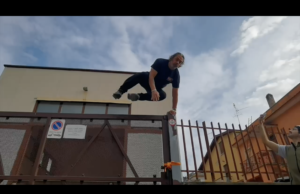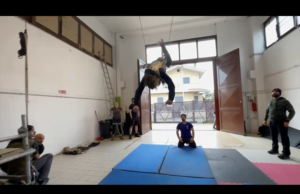
Do you have an adrenaline rush desire and wish to defy gravity, push your limits, and impress audiences with top-level stunts? The thrilling experience of stunt training is where you belong! If you aspire to be a Hollywood stunt double, a death-defying stunt performer, or simply wish to add an extra splash of adventure to your life, learning stunts is an amazing challenge. In this ultimate guide, we’ll venture into the adventurous area of stunt training, providing you with hands-on information, expert tips, and all you need to embark on this incredible journey.
Stunt Training: Unleashing Your Inner Action Hero
Stunt training is a broad range of skills and techniques that allow the performer to design mind–bending stunts without risking themselves too much. From high-speed car chases to fights & freefalls, stuntopportunities are limitless with just one’s imagination and enthusiasm as a limitation. Let us examine the different aspects of stunt training that form the foundation of this exciting career.
1. Physical Conditioning: Building the Foundation
Stunt performers must develop physical strength, agility, and endurance to execute difficult body movements perfectly. An intensive training regimen that includes cardiovascular activities, weight training, and exercise in flexibility is necessary to develop the pertaining physical attributes. Some of the most important skills are a variety of martial arts and gymnastic skills are to begin with a great foundation for aspiring stuntpeople. By training your body to peak levels, you’ll be set to battle the physical stress of different stunt performances.
2. Martial Arts and Combat Techniques: Fists and Fury
Fights, battles, and heroic combat are usually the focus and base of adrenaline-pumping stunts. Training in martial arts and fight skills prepares stunt performers with the ability to execute realistic, effective, and safe fight scenes. Combat techniques such as judo, karate, and stage combat enable artists to execute perfect punches, kicks, and throws and stunning acrobatic movements with less risk of injury.
3. Wirework and Aerial Stunts: Taking Flight
Achieving the illusion of defying gravity is a hallmark of many extraordinary stunts. Wirework and aerial stunts enable performers to soar through the air, performing astonishing maneuvers that captivate audiences. By mastering the art of harnesses, cables, and rigging, stunt professionals can execute daring mid-air flips, breathtaking descents, and graceful suspensions, transporting spectators into a world of pure amazement.
4. High Falls and Descents: The Art of Controlled Plummets
From leaping off towering skyscrapers to falling down mountains, high descends and falls are a characteristic of action films and live performances. Stunt training equips the performers with skills necessary to undertake these danger seeking activities safely. Airbag, controlled fall by descenders, and proper timing are skills that allow the performer to create the illusion of high-risk leaps without the resulting risk of injury.

5. Car Stunts: Mastering the Wheel
Car chases at high speeds, dramatic crashes, and unbelievable stunts with vehicles are a key element of the majority of blockbuster movies. It requires a combination of driving ability, precise maneuvering, and an understanding of vehicle physics to master car stunts. Whether performing cool drifts or precise jumps, precision driving training enables an individual to perform high-speed stunts in a car with confidence and poise.
6. Fire Stunts: Confronting the Flames
For the serious adrenaline junkies, fire stunts pushes the art of skill and bravery to the extreme. Full burns and partial body burns, and all kinds of fire stunts require expert training to keep the performers safe. Expert stunt artists learn to handle fire-proof materials, fireproof clothing, and the subtle manipulation of pyrotechnic effects to create dazzling visuals while maintaining the risks to a bare minimum
7. Water Stunts: Making a Splash
From heart-stopping dives to breathtaking underwater shots, water stunts add a dash of danger and thrill to the production. Diving courses gives one the skill to perform water stunts safely. Skills such as swimming, diving, and breath control are required to execute breathtaking underwater scenes, and water safety expertise ensures a safe environment for actors and stunt performers.
8. Precision Driving: Navigating the Edge
Precision driving is a crucial skill for stunt performers involved in car chases, car stunts, and vehicle action scenes. Mastering the art of precision driving a vehicle requires years of experience and training. Stunt professionals are trained in advanced driving techniques, such as drifting, handbrake turns, and controlled spins, which enable them to execute high-speed maneuvers with ease and safety.
9. Weapons and Props: The Art of Illusion
Stunt training involves practice with a wide variety of weapons and props in coming up with exciting and realistic action scenes. From sword fights to the handling of firearms, and from the utilization of all kinds of weapons and props, stunt performers are required to learn how to work safely with these items. Training involves understanding the mechanics of different weapons, integrating choreographed combat sequences, and following strict safety protocols to come up with a realistic but safe performance.
10. Acting and Performance Skills: Bringing Characters to Life
Apart from the bodily aspect of stunts, acting and performance skills are needed to be able to deliver convincing and compelling performances. Stuntmen double as performers or play smaller or bigger parts in movies or shows and must idealistically get inside their characters and execute complicated stunts flawlessly at the same time. Training comprises learning how to get into the head of a character, establishing emotional complexity, and closely working with choreographers and directors in order to ensure the script takes off.
FAQs about Stunt Training
What is a stunt career?
A stunt career involves performing daring and often dangerous actions or sequences for movies, television shows, live performances, or other entertainment productions.
What do stunt performers do?
Stunt performers are skilled professionals who specialize in performing action sequences, such as fight scenes, car chases, falls, and other physically demanding stunts. They often double for actors and actresses, performing the risky or physically demanding aspects of a scene.
How do I become a stunt performer?
Becoming a stunt performer typically involves a combination of physical training, experience in various disciplines (e.g., martial arts, gymnastics), and networking within the industry. Many stunt performers start by working as extras or background actors and gradually gain experience and build their stunt skills.
Is formal education required for a stunt career?
There is no specific formal education requirement for a stunt career. However, it can be beneficial to have training or experience in disciplines such as martial arts, gymnastics, or dance, as well as knowledge of safety procedures and equipment.
What are the physical requirements for a stunt career?
Stunt performers need to be in excellent physical condition. They should possess strength, agility, flexibility, and stamina to perform demanding physical actions repeatedly and maintain safety during stunts. It is important to maintain a healthy lifestyle and engage in regular physical training.
Are there any risks involved in a stunt career?
Yes, stunt work can be dangerous and involves certain risks. Stunt performers must be willing to take calculated risks and follow strict safety protocols to minimize the chance of injury. Professional stunt coordinators and safety teams are always present on set to ensure the well-being of the performers.
How much do stunt performers earn?
Earnings for stunt performers can vary widely depending on factors such as experience, the scale of the production, and union affiliation. Stunt performers are typically paid on a per-project basis, and rates can range from modest to substantial for high-profile projects.
Are there any professional organizations for stunt performers?
Yes, there are professional organizations such as the Stuntteam.org, This organization provide Stunt Training, Workshop, Academy, School support, resources, and networking opportunities for stunt professionals.
Can I pursue a stunt career part-time?
While some stunt performers work on a part-time basis, it is generally a full-time commitment due to the irregular nature of the work and the need for continuous training and availability. However, opportunities for part-time or occasional stunt work may be available depending on the local industry and demand.
What other skills are beneficial for a stunt career?
In addition to physical abilities, other skills that can be beneficial for a stunt career include acting skills, knowledge of different types of vehicles and equipment, familiarity with special effects, and an understanding of camera angles and choreography.
What qualifications do I need to pursue a career in stunt training?
To pursue a career in stunt training, there are no specific academic qualifications required. However, a strong background in sports, martial arts, gymnastics, or related disciplines can be beneficial. It’s important to have a passion for performing stunts and a willingness to undergo rigorous training.
Is stunt training dangerous?
Stunt training involves inherent risks, but with proper training, safety measures, and experienced instructors, the risks can be minimized. Safety is always a top priority in the stunt industry, and professionals work closely with trained coordinators and use specialized equipment to ensure the well-being of performers.

